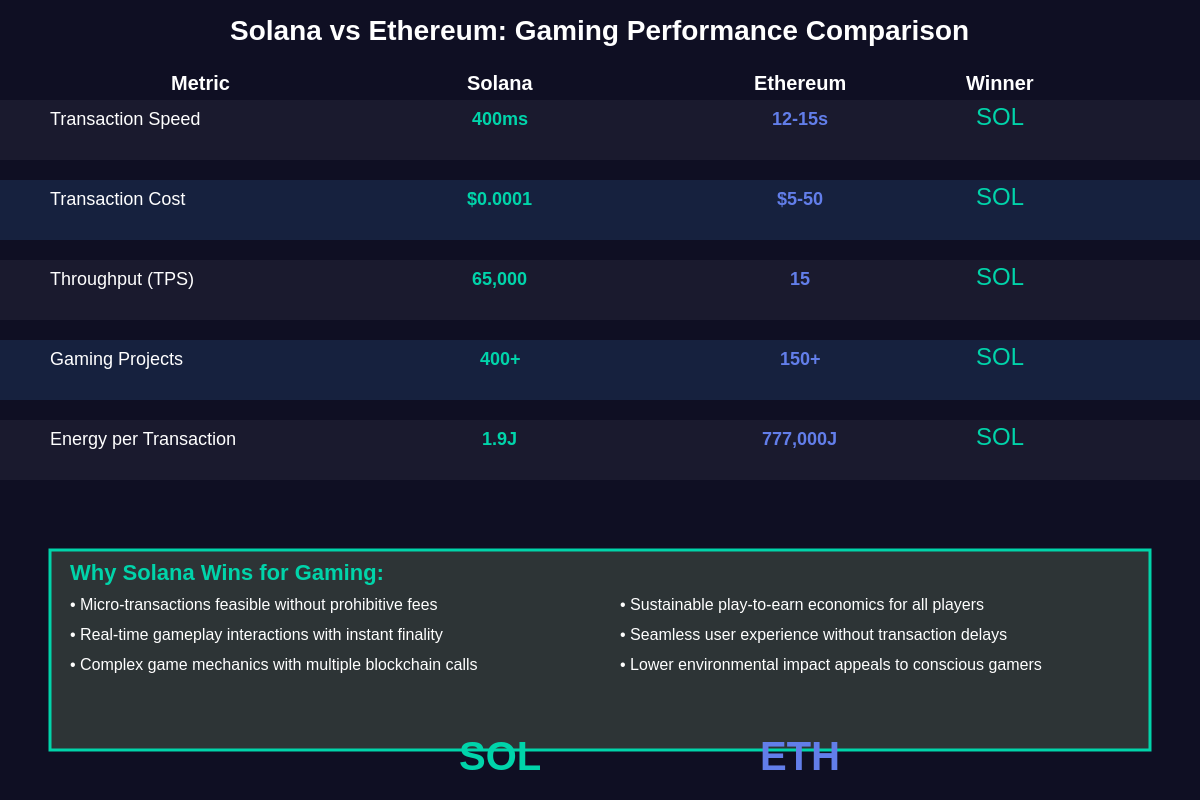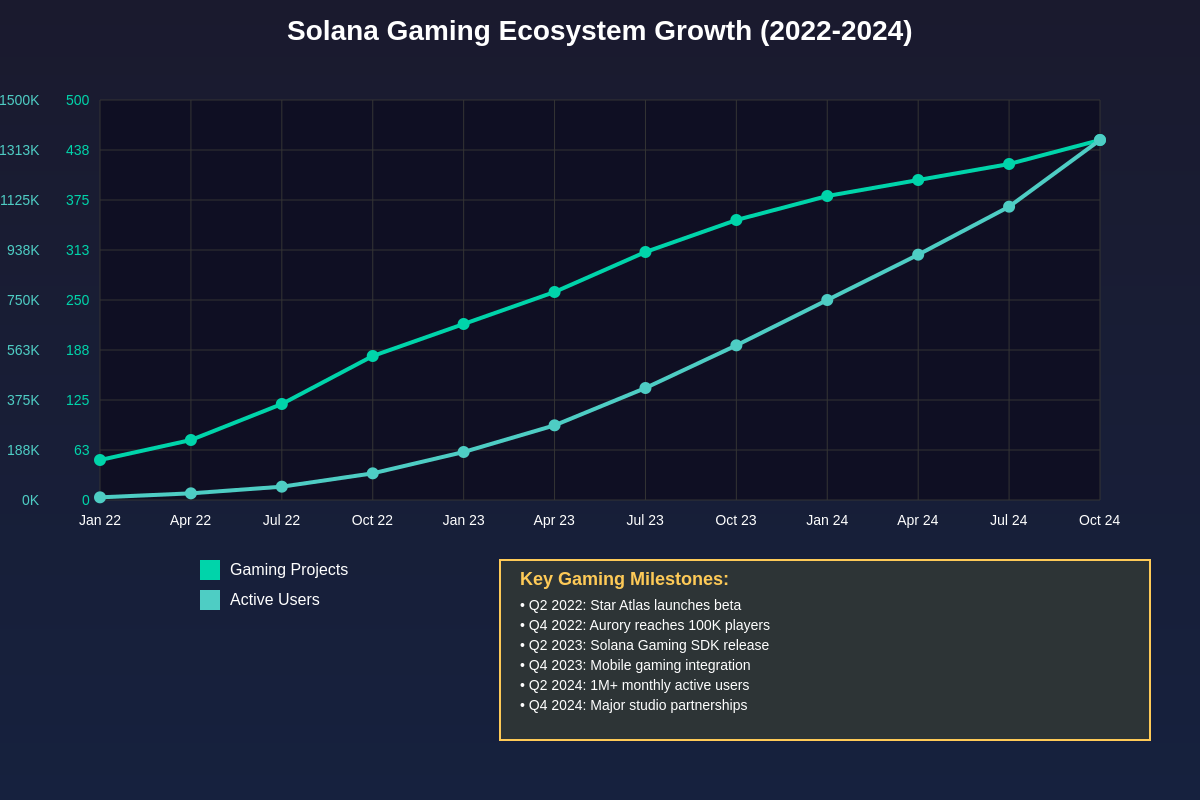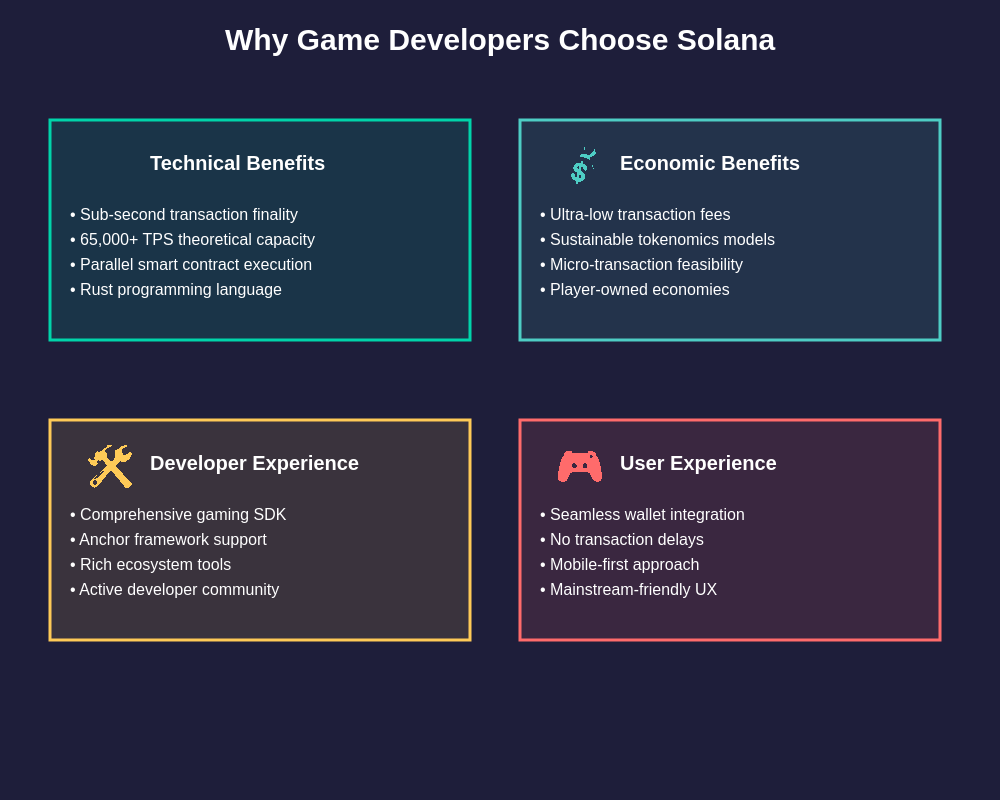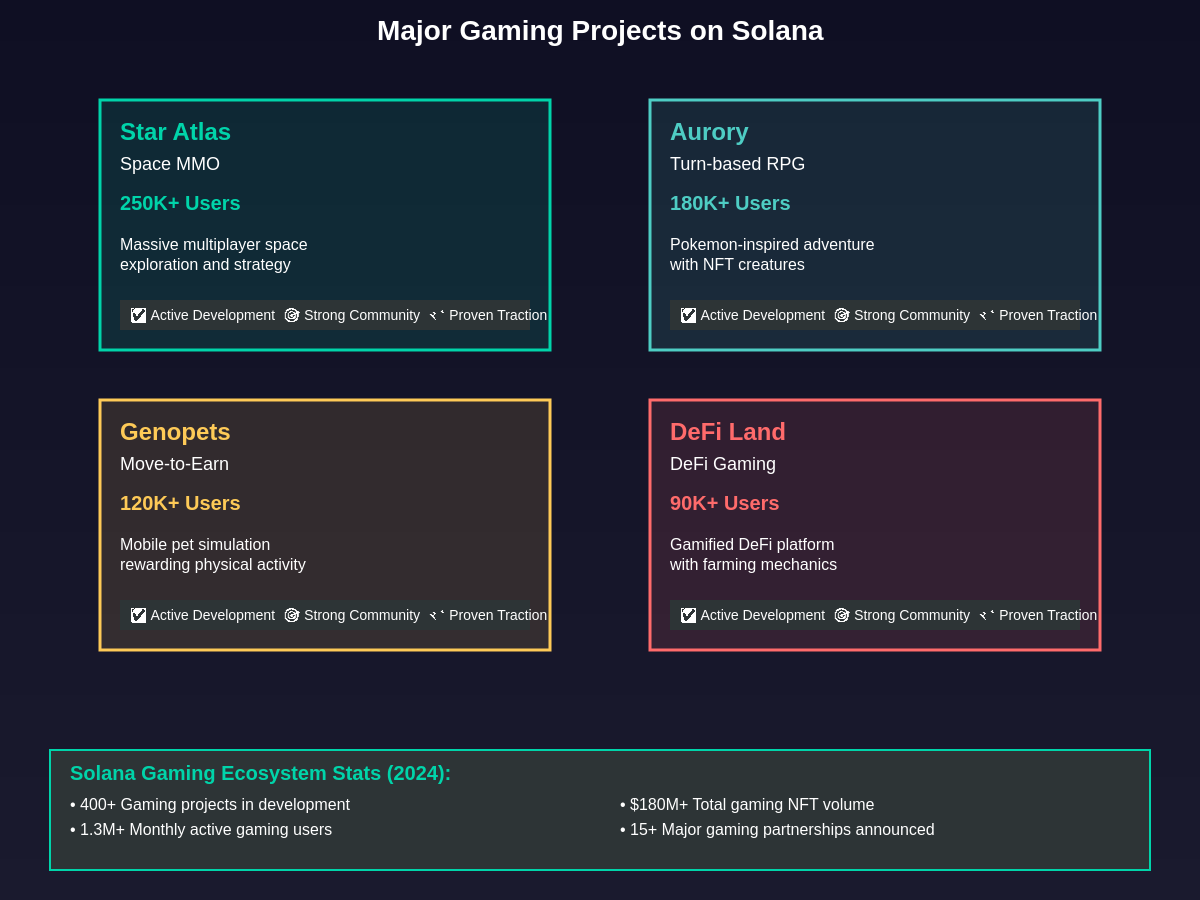Explore Solana’s performance metrics on TradingView to understand the blockchain’s growth alongside its gaming ecosystem development.
The Gaming Revolution on Solana
The landscape of blockchain gaming has undergone a dramatic transformation over the past two years, with Solana emerging as the preferred platform for Web3 game developers who previously would have defaulted to Ethereum. This shift represents more than just a technical preference—it signals a fundamental reimagining of what blockchain gaming can achieve when freed from the constraints of high transaction costs and network congestion that have historically plagued Ethereum-based gaming applications.
Solana’s gaming ecosystem has experienced exponential growth, with over 400 active gaming projects currently in development or already launched on the network, compared to just 50 projects in early 2022. This dramatic expansion has been driven by the blockchain’s unique technical capabilities that address the specific requirements of gaming applications, including sub-second transaction finality, negligible transaction costs, and the ability to handle thousands of transactions per second without compromising user experience.
The gaming industry’s migration to Solana has been particularly pronounced among developers creating complex, real-time gaming experiences that require frequent blockchain interactions. Unlike traditional gaming applications that might interact with a blockchain only for major events like purchasing or trading items, modern Web3 games often require continuous blockchain communication for features like real-time leaderboards, micro-transactions, social interactions, and dynamic game state updates that would be prohibitively expensive on higher-cost networks.
Technical Advantages Driving Developer Adoption

The technical architecture of Solana provides several critical advantages that make it particularly well-suited for gaming applications compared to Ethereum and other blockchain networks. The network’s innovative Proof of History consensus mechanism enables it to process transactions with remarkable speed and efficiency, achieving theoretical throughput of up to 65,000 transactions per second while maintaining transaction costs that typically remain below $0.01 per transaction.
For gaming applications, this technical capability translates into practical advantages that directly impact user experience and game design possibilities. Players can perform multiple in-game actions without worrying about accumulating significant transaction fees, enabling game mechanics that would be impossible or impractical on networks with higher transaction costs. This includes features like frequent micro-transactions, real-time trading of in-game assets, social gaming features that require blockchain interactions, and complex game mechanics that involve multiple smart contract calls per user action.
The network’s parallel processing capabilities represent another significant advantage for gaming applications, as Solana can execute multiple smart contracts simultaneously rather than processing them sequentially as Ethereum does. This capability is particularly valuable for multiplayer games and gaming platforms that need to handle numerous concurrent user interactions without creating bottlenecks or delays that would negatively impact gameplay experience.
Solana’s programming model using Rust and its account-based architecture provide developers with greater flexibility in designing complex gaming applications compared to Ethereum’s virtual machine approach. This architectural difference enables more efficient data storage and retrieval patterns that are particularly beneficial for games that need to maintain complex game states, player inventories, and social features that require frequent database-like operations.
Performance Metrics and Network Efficiency
The performance differential between Solana and Ethereum for gaming applications becomes apparent when examining real-world metrics from active gaming projects. Analyze current Solana network performance to see how network efficiency correlates with gaming adoption rates and user engagement metrics.
Gaming applications on Solana typically experience transaction confirmation times of 400-600 milliseconds, compared to Ethereum’s 12-15 second block times that can extend significantly during periods of network congestion. This difference is crucial for gaming applications where delayed transactions can disrupt gameplay flow and create poor user experiences that drive players away from Web3 gaming platforms.
Transaction cost analysis reveals even more dramatic differences between the networks, with typical gaming transactions on Solana costing between $0.0001 and $0.001, while similar transactions on Ethereum can range from $5 to $50 or more during periods of high network activity. This cost differential fundamentally changes the economics of game design, enabling developers to create games with frequent micro-transactions, social features, and complex gameplay mechanics without worrying about transaction costs exceeding the value of in-game activities.
The network’s energy efficiency also represents a significant advantage for gaming companies concerned about environmental impact and sustainability messaging. Solana’s consensus mechanism consumes significantly less energy per transaction compared to Ethereum’s current proof-of-work system, though this advantage will be less pronounced as Ethereum continues its transition to proof-of-stake consensus.
Network reliability and uptime represent areas where Solana has faced challenges, with several notable outages occurring during periods of high network stress. However, the network’s performance has improved significantly over time, and gaming developers have generally found that the benefits of low costs and high throughput outweigh the occasional reliability concerns, particularly as the network has implemented various stability improvements.
Major Gaming Projects and Success Stories

The Solana gaming ecosystem includes several high-profile projects that demonstrate the platform’s capabilities and have achieved significant user adoption and commercial success. Star Atlas represents one of the most ambitious projects, combining space exploration, strategy gaming, and economic simulation in a massively multiplayer online experience that leverages Solana’s capabilities for real-time transactions and complex economic interactions between players.
Aurory has achieved significant success as a turn-based RPG that combines traditional gaming elements with blockchain-based asset ownership and trading. The project has demonstrated how Solana’s low transaction costs enable frequent interactions with blockchain systems without creating barriers to gameplay, allowing players to trade items, participate in battles, and engage with social features without worrying about prohibitive transaction fees.
The success of gaming-focused NFT projects like Okay Bears and DeGods has created a vibrant ecosystem of digital assets that can be integrated into gaming applications, providing developers with established communities and asset bases to build upon. These projects have demonstrated the potential for cross-game asset interoperability that becomes more practical when transaction costs are low enough to support frequent asset transfers and interactions.
Genopets has pioneered the “move-to-earn” gaming model on Solana, creating a pet simulation game that rewards players for physical activity tracked through mobile devices. The project’s success demonstrates how Solana’s capabilities enable innovative game mechanics that combine real-world activities with blockchain-based rewards and progression systems.
Smaller indie gaming projects have also found success on Solana, with the low barrier to entry for blockchain interactions enabling experimental game designs and niche gaming experiences that might not be economically viable on higher-cost networks. This has created a diverse gaming ecosystem that ranges from simple casual games to complex multiplayer experiences and everything in between.
Developer Tools and Infrastructure

The Solana gaming ecosystem benefits from a robust set of developer tools and infrastructure services specifically designed to support gaming applications. The Solana Game SDK provides developers with pre-built components for common gaming functionality like wallet integration, NFT management, and marketplace integration, significantly reducing the development time required to create blockchain-integrated games.
Anchor framework has emerged as the standard development framework for Solana applications, providing developers with higher-level abstractions that simplify smart contract development while maintaining the performance benefits of the underlying Solana architecture. For gaming developers, Anchor provides particularly useful features for managing game state, handling player interactions, and implementing complex game mechanics that require multiple smart contract interactions.
Infrastructure services like GenesysGo, Triton, and other RPC providers offer specialized services for gaming applications that require high-performance blockchain interactions. These services provide features like priority transaction processing, dedicated RPC endpoints, and specialized caching that can improve the performance of gaming applications and provide more predictable user experiences.
The development of gaming-specific tools continues to accelerate, with companies like Magic Eden, Metaplex, and others creating specialized services for gaming NFTs, in-game marketplaces, and player identity management. These tools reduce the complexity of integrating blockchain functionality into games while providing proven, battle-tested solutions that gaming developers can rely upon.
Cross-platform development tools have also emerged to help developers create games that can run on multiple devices while maintaining consistent blockchain integration. This is particularly important for mobile gaming, where the majority of players expect seamless experiences that don’t require complex wallet management or technical blockchain knowledge.
Economic Models and Tokenomics
The economic models enabled by Solana’s low transaction costs have fundamentally changed how developers approach game monetization and player incentives. Traditional free-to-play games rely heavily on a small percentage of high-spending players, but blockchain games on Solana can implement more distributed economic models where a larger percentage of players can participate in the game economy through small, frequent transactions.
Play-to-earn mechanics become more viable when transaction costs don’t consume the majority of earned rewards, enabling games to provide meaningful value to players even for small accomplishments or contributions to the game ecosystem. This has led to the development of games where players can earn modest but meaningful amounts through regular gameplay, creating sustainable economic loops that benefit both players and developers.
The concept of player-owned economies has evolved on Solana to include more sophisticated models where players can participate in governance, profit-sharing, and economic decision-making within games. Low transaction costs enable voting mechanisms, governance participation, and community-driven economic adjustments that would be impractical on higher-cost networks.
Tokenomics designs for Solana games often incorporate multiple tokens with different utilities, including governance tokens, utility tokens for in-game purchases, and reward tokens for player achievements. The low cost of token transactions enables more complex economic interactions between these different token types without creating prohibitive costs for players who want to participate in all aspects of the game economy.
Revenue sharing models between developers and players have become more sophisticated on Solana, with some games implementing systems where players who contribute to the game’s success through community building, content creation, or competitive achievement can share in the game’s revenue through token distributions or other reward mechanisms that would be too expensive to implement on higher-cost networks.
Comparison with Ethereum Gaming
The comparison between Solana and Ethereum for gaming applications reveals fundamental differences in approach and capabilities that have led to the migration of many gaming projects to Solana. Ethereum’s higher transaction costs and slower confirmation times create barriers to frequent blockchain interactions that are essential for many modern gaming experiences.
Ethereum gaming projects typically minimize blockchain interactions to reduce costs, often implementing game mechanics where only major events like item purchases or character upgrades require blockchain transactions. This approach limits the integration between gameplay and blockchain features, creating a more traditional gaming experience with blockchain elements added rather than a truly integrated Web3 gaming experience.
The development complexity for gaming on Ethereum is generally higher due to gas optimization requirements and the need to carefully manage smart contract interactions to minimize costs. Developers must consider the gas costs of every function call and often implement complex batching mechanisms to reduce the number of separate transactions required for game operations.
Compare SOL and ETH performance metrics to understand how network performance differences translate into practical advantages for gaming applications and user adoption rates.
User experience differences between the platforms are significant, with Ethereum gaming often requiring players to approve multiple transactions for complex operations and wait for confirmation times that can disrupt gameplay flow. Solana gaming applications can provide more seamless experiences where blockchain interactions happen transparently without interrupting gameplay.
The ecosystem differences also play a significant role, with Ethereum having a more mature DeFi ecosystem that can be integrated into gaming applications, while Solana’s gaming-focused ecosystem provides more specialized tools and services designed specifically for gaming use cases. Each approach has advantages depending on the specific requirements of the gaming application.
Challenges and Limitations
Despite its advantages for gaming applications, Solana faces several challenges that developers must consider when choosing the platform for their gaming projects. Network stability has been a recurring concern, with several high-profile outages that temporarily prevented users from accessing their games and assets. While the network’s stability has improved significantly, the risk of outages remains a consideration for developers building mission-critical gaming applications.
The Solana ecosystem is less mature than Ethereum in terms of institutional adoption, regulatory clarity, and established protocols for certain types of financial interactions that might be relevant for gaming applications. This can create challenges for gaming projects that want to integrate with traditional financial systems or operate in regulated markets.
Developer tooling, while improving rapidly, is still less comprehensive than what’s available for Ethereum development. Gaming developers might find fewer resources, tutorials, and community support compared to Ethereum, though this gap is closing as the Solana gaming ecosystem continues to grow.
The network’s consensus mechanism, while efficient, is more complex than some alternatives and requires a deeper understanding of Solana’s unique architecture for developers who want to optimize their applications for maximum performance. This learning curve can be a barrier for developers transitioning from other blockchain platforms.
Interoperability with other blockchain networks remains limited compared to Ethereum’s extensive bridge infrastructure, which can be a limitation for gaming projects that want to integrate assets or features from multiple blockchain ecosystems. However, this limitation is becoming less significant as the Solana ecosystem develops its own comprehensive set of gaming-focused services and assets.
Future Developments and Roadmap
The future of Solana gaming appears promising with several significant developments on the horizon that will further enhance the platform’s capabilities for gaming applications. The upcoming Firedancer validator client promises to increase network performance and stability, potentially enabling even more sophisticated gaming applications that require higher throughput and more predictable performance.
Mobile integration represents a major focus area for Solana gaming development, with the Solana Mobile Stack and Saga phone providing native blockchain integration that could enable new types of mobile gaming experiences. The development of mobile-first gaming applications that take advantage of built-in wallet functionality and seamless blockchain interactions could drive significant adoption among mainstream mobile gaming audiences.
Cross-chain gaming protocols are being developed to enable asset and player interoperability between Solana and other blockchain networks, potentially allowing players to use assets from multiple blockchains within Solana games while maintaining the performance benefits of the Solana network for gameplay interactions.
The integration of artificial intelligence and machine learning capabilities into Solana gaming applications represents another significant development area, with projects exploring how AI can enhance gameplay, create dynamic content, and provide personalized gaming experiences while leveraging Solana’s performance capabilities for real-time AI processing.
Virtual and augmented reality gaming represents a frontier where Solana’s performance advantages could be particularly significant, as VR and AR applications require extremely low latency and high throughput to provide acceptable user experiences. Several projects are exploring how Solana’s capabilities can enable new types of immersive gaming experiences that incorporate blockchain elements.
Investment and Market Dynamics

The investment landscape for Solana gaming has evolved significantly as the platform has demonstrated its technical capabilities and attracted high-quality gaming projects. Venture capital firms and gaming-focused investors have increased their focus on Solana gaming projects, recognizing the platform’s advantages for creating sustainable, scalable gaming businesses.
Gaming token performance on Solana has generally outperformed similar projects on other blockchains, though this success has been driven by both technical advantages and broader market dynamics that have favored Solana-based projects. The lower barrier to entry for players has generally resulted in larger, more engaged player bases that drive token value through actual usage rather than purely speculative interest.
The correlation between Solana’s native token performance and gaming ecosystem growth has created positive feedback loops where network success drives gaming adoption, which in turn drives network usage and value. Monitor this relationship through SOL price analysis to understand how gaming ecosystem growth impacts overall network value.
Institutional gaming companies have begun to take notice of Solana’s capabilities, with several major gaming studios exploring or announcing plans to develop on the platform. This institutional interest represents a significant validation of Solana’s technical approach and could drive substantial growth in the gaming ecosystem as traditional gaming companies bring their expertise and resources to blockchain gaming development.
The secondary market for Solana gaming assets has developed into a robust ecosystem with multiple marketplaces, trading platforms, and analytical tools that support active trading and price discovery for gaming NFTs and tokens. This market infrastructure is essential for creating sustainable gaming economies where players can realize value from their in-game achievements and investments.
Regulatory and Compliance Considerations
The regulatory environment for blockchain gaming continues to evolve, with different jurisdictions taking varying approaches to the classification and regulation of gaming tokens, NFTs, and play-to-earn mechanics. Solana gaming projects must navigate these regulatory complexities while taking advantage of the platform’s technical capabilities.
The classification of gaming tokens as securities, commodities, or utility tokens remains an area of regulatory uncertainty that affects how gaming projects can structure their tokenomics and player reward systems. Projects on Solana have generally taken conservative approaches to compliance while working with legal experts to ensure their gaming models can operate within existing regulatory frameworks.
International regulatory variations create additional complexity for Solana gaming projects that want to operate globally, as different countries have different rules regarding blockchain gaming, cryptocurrency rewards, and digital asset ownership. The low transaction costs on Solana enable more flexible approaches to compliance, including geo-specific features and region-locked content that can help projects navigate complex regulatory requirements.
The development of self-regulatory standards within the Solana gaming community has emerged as projects work together to establish best practices for player protection, fair gaming mechanics, and responsible tokenomics design. These community-driven standards help create a more sustainable and trustworthy gaming ecosystem that can better withstand regulatory scrutiny.
Privacy considerations have become increasingly important for blockchain gaming, with regulations like GDPR creating requirements for how gaming projects handle player data and provide players with control over their personal information. Solana’s architecture provides certain advantages for privacy-preserving gaming applications, though developers must still carefully consider how they collect, store, and process player data.
The regulatory landscape for blockchain gaming is evolving rapidly, and the Solana ecosystem has positioned itself to adapt to changing requirements while maintaining the technical advantages that make it attractive for gaming development. This adaptability will be crucial for the long-term success of the Solana gaming ecosystem as regulatory frameworks become more established.
This article is for informational purposes only and does not constitute financial, investment, or legal advice. Cryptocurrency investments carry significant risks, including the potential for total loss of capital. The regulatory status of blockchain gaming and associated tokens varies by jurisdiction and may change over time. Readers should consult with qualified professionals before making any investment decisions or participating in blockchain gaming activities. Past performance of gaming tokens or projects does not guarantee future results. The author may hold positions in Solana or related gaming tokens.